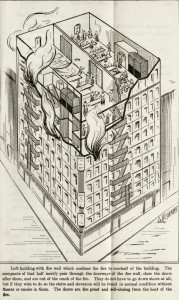Industrial Building Fire Safety in 1911

Building Fire Safety Fire Wall Sketch
from State Of New York Preliminary Report Of The Factory Investigating Commission, 1912 Holbrook Fitz John Porter [more images]
Factory Investigating Commission, Preliminary report of the Factory Investigating Commission, 1912
“On Saturday afternoon, March 25, 1911, a fire took place in the business establishment of the Triangle Waist Company, at No. 23-29 Washington Place, in the Borough of Manhattan, City of New York, in which 145 employees, mainly women and girls, lost their lives.
This shocking loss of life aroused the community to a full sense of its responsibility. A superficial examination revealed conditions in factories and manufacturing establishments that constituted a daily menace to the lives of the thousands of working men. women and children. Lack of precautions to prevent fire, inadequate fire-escape facilities, insanitary conditions that were insidiously undermining the health of the workers were found existing everywhere. The need of a thorough and extensive investigation into the general conditions of factory life was clearly recognized.
Public-spirited citizens and representatives from the Fifth Avenue Association of the City of New York, the Committee on Safety of the City of New York and other organizations laid these facts before the Governor and Legislature of the State and asked for the appointment of a legislative commission to inquire into the conditions under which manufacturing was carried on in the cities of the first and second class of the State. As a result, the Act creating this Commission (Chapter 561 of the Laws of 1911) was passed and became a law on June 30, 1911.”
“The Commission selected as its advisory expert on the fire problem, Mr. H. F. J. Porter, a mechanical engineer of the City of New York, who had made a study of fire problems, had written many articles on the subject and was known to be conversant with the situation. Under his supervision, inspections were made of numerous manufacturing establishments with reference to the fire hazard. For the inspection work and fees of the advisory experts, tho sum of $5,500 was expended by the Commission. Both Mr. Porter and Dr. Price agreed to give their own services for practically nominal sums, and both devoted themselves zealously to the work of the Commission.”
WHAT DID H.F.J. PORTER RECOMMEND?
“It is recommended that all fireproof factory buildings exceeding 85 feet in height be required to have the floor surfaces of incombustible finish, and all doors, trim and interior finish of fire-proof materials, all window frames and sash to be of metal or metal-covered wood, the sash to close automatically and be glazed with wire glass.
It is recommended that all industries whose product or raw materials are highly inflammable, such as celluloid, etc., be prohibited from occupying ordinary factory buildings. Concerns manufacturing such goods should be required to occupy separate or detached buildings, in which the following special features are provided: (1) Fireproof stock and supply rooms with approved fireproof doors and ventilation to the outside. (2) Fireproof receptacles for all waste and rubbish. (3) Metal or fireproof work tables. (4) Artificial light without exposed flames. (5) Hot water heating system. (6) Requirements prescribed by the proper jurisdictions permitting only a designated, limited quantity of inflammable materials or goods in the work room.
It is recommended that approved fire tanks of not less than 15 gallons capacity, with included buckets, be provided to comply with the requirements of the insurance and underwriting rules, instead of the ordinary fire buckets.
It is recommended that fireproof receptacles be required in every factory for all combustible scraps, cuttings, rubbish and other waste; and that it be made compulsory that a sufficient number of employees be detailed to collect such waste and keep the premises clean during the working hours, such waste and rubbish to be removed from the premises at the end of each working day.
It is recommended that firms and individuals be obliged to obtain a license from the proper bureau or jurisdiction, subject to such regulations as may be drafted by such bureau, before they are permitted to engage in business. Before such license shall be issued and before any premises can be occupied as a factory employing more than ten persons exclusive of the office employees, a complete detailed plan shall be filed and be approved by the municipal or state bureaus or officers having jurisdiction. Such plan shall be on a scale not smaller than one-quarter of an inch to the foot, and shall show the exact location and correct dimensions of all exits, machinery or other equipment, light fixtures, electric switchboard, work tables, permanent and temporary partitions, material and supply rooms, stock rooms, drying rooms, toilet rooms, hat and cloak rooms, shelving, fire appliances, desks and all other furniture except chairs or seats.
It is recommended that all new factory buildings intended to be occupied by more than fifty persons above the first floor be of fireproof construction.
It is recommended that smoking in factories in which the raw materials or products are of a combustible nature be made a crime punishable by law.
It is recommended that the sale of all ordinary matches be prohibited, and that safety matches only be permitted on sale in the state.
It is recommended that gasoline, naphtha, and other highly inflammable and volatile liquids be prohibited in factory buildings. Where non-inflammable substitutes are not practicable, limited quantities to be fixed by the proper jurisdiction, to be permitted in approved safety cans and under conditions to be prescribed by the Bureau of Fire Prevention, or other municipal or state bureaus or officers having jurisdiction.”
